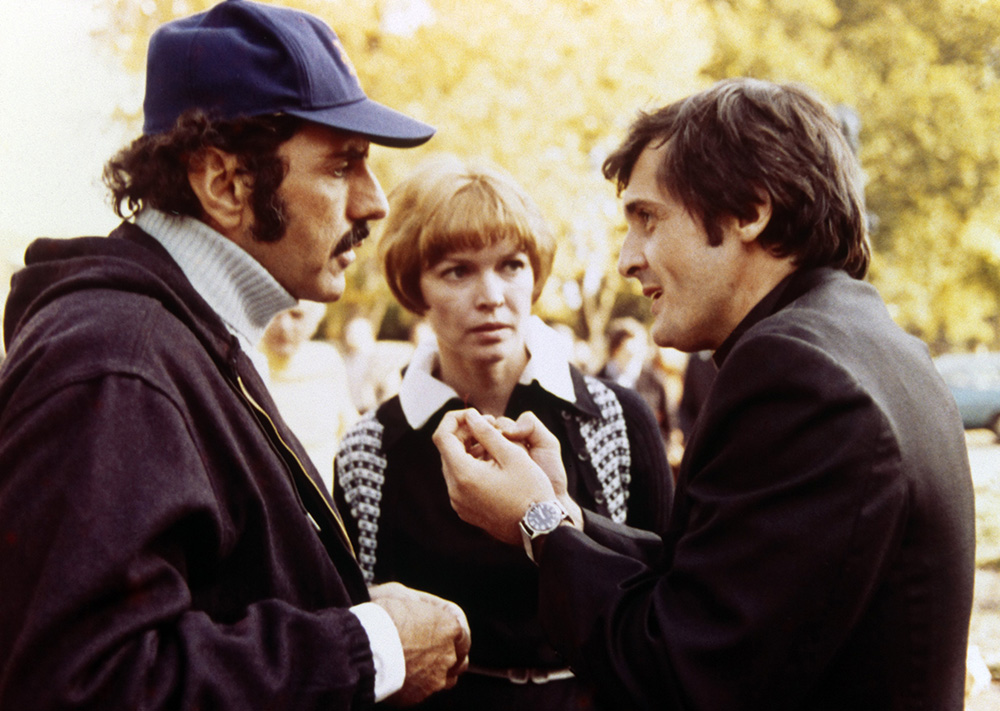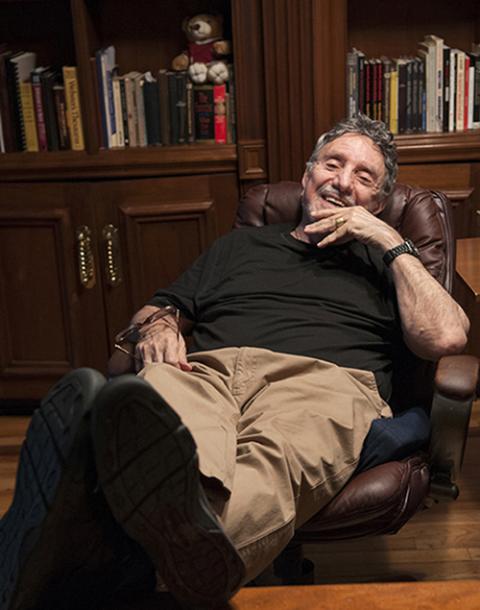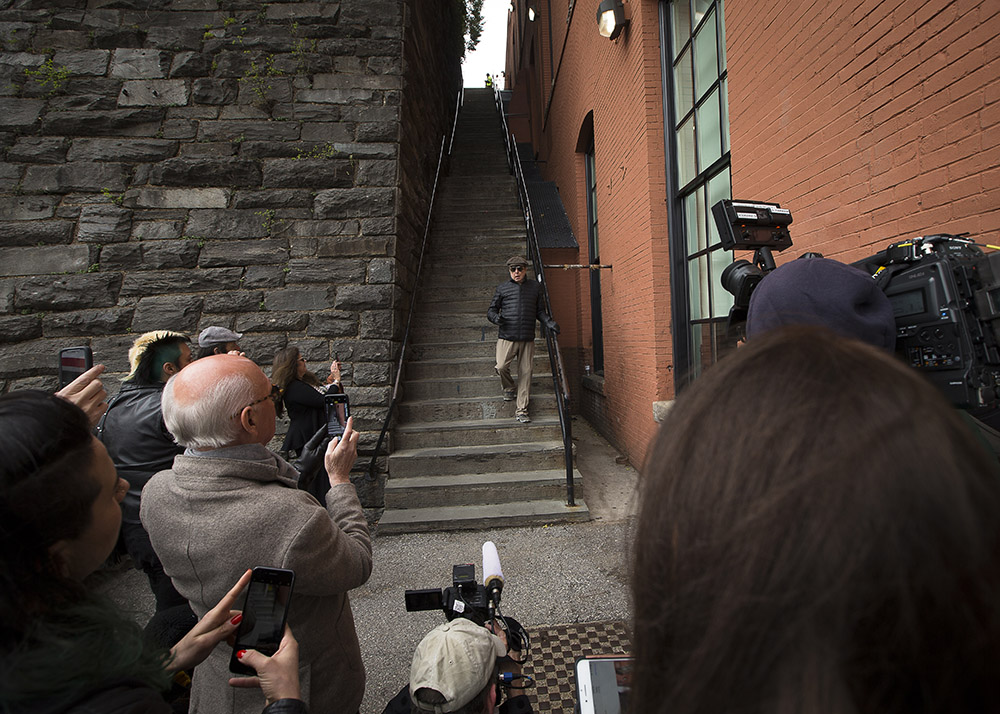
William Peter Blatty, left, speaks with actors Ellen Burstyn and Jason Miller on the set of "The Exorcist" in 1973. (Newscom/Warner Bros./Hoya Productions)
You sometimes don't know when you're auditioning. I certainly had no idea in 2012 when I hosted a book publishing webinar for Georgetown University alumni.
The Exorcist author and screenplay writer William Peter Blatty, class of 1950, lurked undetected in the audience of 100-plus people, and he followed up afterward. He hoped to publish his master's thesis comparing T. S. Eliot and Shakespeare, matching it with outrageously funny photos from his Georgetown days.
When I asked why, Blatty said, "I want to show the world that I am not some horror writer of meat-and-potatoes prose. It is a question of my own pride. My forte was literature."
Most of this article is based on one of our interviews in 2012 in his kitchen with his wife, Julie, nearby. We shared a pastry specially ordered from a Seattle bakery called Larsen's; one slice, two forks. He was chummy and relaxed that way with everyone — a jovial, complex, deeply Catholic guy whose life got sidetracked when one book of several became an accidental bestseller.
I asked if he felt The Exorcist had hijacked his identity. "Oh, yes, it absolutely did. The impression was — pretty much — that I'd landed on the planet with the manuscript under my arm."
Now he wanted people to understand a different side of him. This was a relief, because I secretly wasn't wild about either the book or film, although I had immediately engaged both when I first came to Georgetown in 1997. However, I had only the fondest memories of his other work, especially the classic 1964 Blake Edwards Pink Panther comedy, "A Shot in the Dark."
Blatty was convinced that The Exorcist would make people want to become Catholic, or renew their lapsed faith. As far-fetched as this seemed to me, he was quite sincere about it, and he claimed to have evidence that confessions went up after people viewed the movie in Catholic-heavy New York.

Despite subfreezing temperatures and rain, a crowd waits in line outside the Paramount Theater in New York City Feb. 4, 1974, for a showing of "The Exorcist." (AP/Ron Frehm)
Through our conversations and my own reading of his earlier books, I came to see it differently. I thought it animated a very personal tension within Blatty himself between his start as an awkward kid from an immigrant household to bon vivant, moving in upper-class, largely white Catholic circles. Eventually, he did reconcile the two, but not without wrenching conflict that plays out in the exorcism scenes.
To understand how a Catholic humorist with a light touch became the author of The Exorcist, I recommend Blatty's witty 1960 semi-autobiographical book, Which Way to Mecca, Jack?
Mecca is one vast bundle of mother issues, and so — according to Blatty — was his life. But even though he grew up poor with an enterprising single mother who spoke Arabic better than English, and even though he longed to escape her nagging grasp, he gave her credit for pushing him to apply to the Jesuits' Brooklyn Prep in the early 1940s, and then to Georgetown, both on full scholarships. He loved her very much.
At Brooklyn Prep ("not peopled by mere Irishmen, but wealthy Irishmen!"), he felt the contrast between his background and theirs. He was class president for six terms and valedictorian. He made a lifelong friend in Penn State icon Joe Paterno, the quarterback of the football team. There, the Jesuits in some ways made up for the father who'd left when Blatty was a child.
At Georgetown from 1946 to 1950, although he arrived terrified, he eventually became highly involved in its dramatic troupe, the Mask and Bauble Society. He and Jesuit priest Royden Davis, for whom Georgetown's Davis Performing Arts Center is now named, also started their own irreverent "Flask and Bottle Society" for skits.
Advertisement
Blatty was a popular student who seemed to know everyone. Tall, red-haired Jesuit Fr. Leo Monaghan was his dorm hall monitor and became his counselor and friend. Monaghan celebrated Blatty's first marriage at Georgetown's Jesuit parish, Holy Trinity Catholic Church, when the young couple were college seniors.
In Mecca, Blatty describes himself as a scrappy, somewhat naive freshman who desperately wanted to fit in, "filling in the elements of a new identity, stealing this habit and that grace, this way of dressing and that way of acting from the hordes of refined, wealthy young gentlemen of fine old New England homes."
His anxiety was enormous, because although he was matinee-idol handsome, he was also swarthy for provincial midcentury America's taste. Today, he would fit in perfectly on the global campus, but in 1946 he felt like an object of attention and conversation.
Thanks to his mother, Blatty spoke Arabic, a skill that may have botched his CIA interview (they didn't trust it), but did land him a job with the Air Force in its psychological warfare division. He later became an Arabic-language USAID officer and moved his young family to Beirut.

William Peter Blatty in his home office in 2009 (Wikimedia Commons/J.T. Blatty)
There, he appreciated his mother even more as he discovered how her quirks that embarrassed him in Brooklyn, such as selling quince jelly on the street to passersby and once even giving a jar to President Franklin Roosevelt ("for when you have company!"), were perfectly normal in Lebanese culture.
However, he also encountered profound distrust between Christianity and Islam.
In Baghdad, he befriended an aging Jesuit who struggled as a minority Christian in a Muslim country. "He paused uncertainly," Blatty wrote in Mecca, quoting the priest as saying, "Something sinister, something frightful is incubating, and there may soon be Christian martyrs in the streets of the city." It is a somber passage in an otherwise lighthearted book.
Then he traveled to bleak Kirkuk in northern Iraq. This prefigures the prologue of The Exorcist, which also begins in northern Iraq, where Irish Catholic priest and archaeologist Fr. Lankester Merrin finds an icon of the demon that will eventually possess a child. Blatty told my then-graduate assistant Joshua Canzona that he based Merrin in part on French paleontologist and theologian Jesuit Teilhard de Chardin.
What was Blatty really saying about Catholicism and Islam? Did he think the Catholic church would save us, or him in particular? Did he associate Islam with the devil?
I doubt he meant to demonize Islam, because he was far too urbane for something so binary. However, I do think Which Way to Mecca, Jack? and the later The Exorcist dramatize fundamental Christian-Muslim tensions that he said he experienced as a minority.
The "devil" might be a metaphor for interreligious conflict itself, manifesting in wars, bombings and strife. It is also, Blatty told me, the racism he encountered from a few of those not-so-chummy Georgetown Catholics at midcentury, although he chose not to talk about it as much.
"For years," he wrote in Mecca, "I played a bewildering game of touch-tag between an inferiority complex and megalomania."

William Friedkin, director of the 1973 film "The Exorcist" walks down the steps on Prospect Street in Washington, D.C., on April 17, 2018, where the character of Fr. Damien Karras tumbled to his death in the movie. (CNS/Tyler Orsburn)
On Oct. 15, 2015, Georgetown University and Washington, D.C., commemorated the infamous "Exorcist Steps" on Prospect and 36th streets as a historical landmark. I brought my colleague Doreen Metzner, a Georgetown faculty member who as a student in the early 1970s was an extra in the library scene, standing next to actor Jason Miller (who played Damien Karras).
As Blatty's guests, we were invited to come in the back way, and we walked down those iconic steps through purple stage lights and smoke toward the assembled crowd, stepping slowly along with a booming, horror-movie soundtrack. Blatty and director William Friedkin were on hand to speak and sign autographs. The gathered fans, many in costume, were delighted.
The Exorcist clearly lives on in Georgetown in so many little things: the Car Barn where I work, the famous steps next to it, the house, theology professor and former Jesuit Alan Mitchell who was in a scene, art professor emeritus Clifford Chieffo who advised (plus others), and even the airplanes that roar overhead as one of the film's earliest inside jokes.
By dramatizing his internal struggle, Blatty touched something deeper than most of us understand about how our world wars with itself today, too often along Christian and Islamic lines. William Peter Blatty didn't offer any answers. But he was brilliant at asking — and living — resonating questions.








